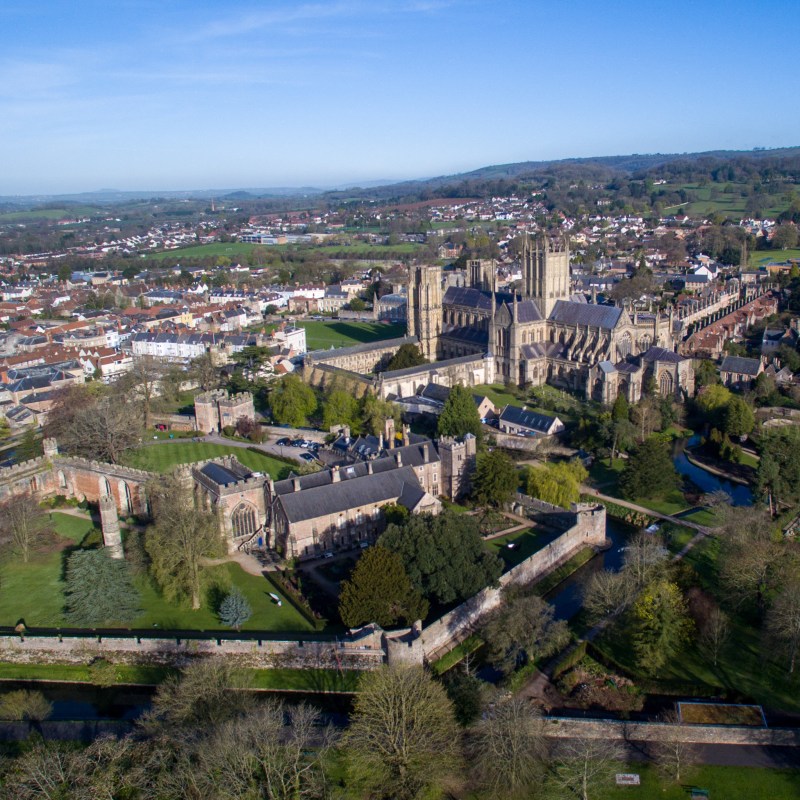
With its cobbled streets, medieval architecture, market square, and leisurely pace, the city of Wells in Somerset, England, feels like a traditional English village, but it is a city — one of the smallest in England. It is located on the southern edge of the Mendip Hills, a designated Area of Outstanding Natural Beauty. Its history dates to Roman times. Today, it boasts a magnificent cathedral, charming narrow streets, an eclectic mix of building styles, and lively markets. It is a delightful city to explore and stroll through.
Videos by TravelAwaits
Here are just a few of the reasons you’ll fall in love with tiny Wells.

1. You’ll Be Awed By Wells Cathedral
The main attraction in Wells is its impressive cathedral. Your first view of the grand West Front of the cathedral from the wide green lawn in front of it will take your breath away. The entire limestone wall is filled with ornate niches overflowing with statues; around 300 of the original 400 statues remain. Construction began in 1175, and the structure was the first English cathedral to be built in the Gothic style.
The interior is as impressive as the exterior, and there is much to explore. The cathedral houses one of the largest collections of historic stained glass in the country. Look for the 14th-century Jesse Window. It traces the genealogy of Jesus all the way back to Abraham.

The Scissor Arches supporting the central towers may look like modern additions, but they were constructed in 1338 to 1348 to solve an issue with cracks in the foundation, which wasn’t stable enough to support the lead-covered wooden spire erected in 1313.
A not-to-be-missed feature of the cathedral is the Wells Clock, dating to 1390 and considered to be the second-oldest working clock mechanism in Britain — and possibly in the world — to have survived in its original condition. The astronomical clock has 24 marks for each hour of the day and displays the motions of the sun and the moon. On each quarter hour, jousting knights race around the clock, and the Quarter Jack bangs the hours with his heels.
The undercroft of Wells Cathedral served both as a crypt and a treasury. It features rugged arched pillars to support the octagonal Chapter House built on top of it. In the Chapter House, where canons once met daily to discuss cathedral business, you’ll find stained glass windows and mischievous faces carved into the walls.
You can tour the cathedral on your own or on a guided tour. The main cathedral area is wheelchair accessible, although visitors are reminded that some areas of paving may have become uneven over time. The Chapter House and library are accessible only via stairs. See the website for full accessibility information.
You may wish to stay or return for Choral Evensong. The choral tradition at Wells Cathedral dates back more than 800 years. The Wells Cathedral Choir has toured extensively and broadcasts regularly on BBC Radio 3. The church organ dates to an instrument built in 1857. When I visited, I was lucky enough to catch an organist practicing, and I spent several minutes in the nave enjoying the music.

2. The Wells Market Place Is A Fun Place To Take A Break
A Gothic-style market cross with a fountain marks the entrance to the Wells Market Place, which has been a focal point of the city for ages. The square at the top of High Street is a good place to start your visit to Wells or to take a break during the day. Enjoy a cup of coffee and a pastry or sandwich at one of the cafes on the edge of the square. On a nice day, you can sit at an outside patio table where you’ll have views of two medieval gateways.
The Penniless Porch entrance to the cathedral was built around 1450; beggars once came here to ask for alms. Today it is a popular site for buskers. The three-story stone Bishop’s Eye is flanked by two turrets and is the gateway to The Bishop’s Palace.

3. You Can Enjoy A Medieval Palace And Garden With Resident Swans
Surrounded by a moat, The Bishop’s Palace has been the home of the bishops of Bath and Wells for more than 800 years. Look for the swans living in the moat as you cross the drawbridge to enter the grounds. They ring bells located on either side of the gatehouse when they want to be fed.
On the other side of the drawbridge, you’ll find 14 acres of RHS Partner Gardens, a peaceful space with lawns, flowerbeds, a formal garden, and an arboretum. In the palace, you can walk around the undercroft and up the staircase to what would have been the rooms of Bishop Jocelin, for whom the palace was originally built. Portraits of past bishops hang in the Long Gallery. Other rooms contain art and history exhibits.
Other attractions include a chapel on the grounds, built between 1275 and 1292 in the Early English Decorated style, and the remaining two walls and four corner turrets of what was once the Great Hall.
The springs that gave the city of Wells its name are also located on the grounds. Adjacent to the pools is Wells House, built in 1451 as part of the water system set up by Bishop Thomas Beckynton to provide fresh water to the townspeople.
You can explore the grounds for free and take in the impressive view of the palace set at the back of an expansive green space. Have a bite to eat on the patio of The Bishop’s Table and take in the serenity of the surroundings. Admission is required to enter the palace, see the other attractions, and more fully explore the grounds.
There is also a pretty walk alongside the moat just outside the palace grounds. You can watch the ducks and swans in the moat as you walk. On the other side of the moat, a stone wall with bits of foliage growing over it makes a lovely backdrop. To get to this walkway, turn right after entering the Bishop’s Eye before crossing the drawbridge into The Bishop’s Palace.

4. There’s Plenty Of Shopping
Shopping or browsing in the city’s historic core is an unhurried, pressure-free experience. While the shopping area is not large compared to those in larger cities, there is a decent selection of stores. Additionally, many of the stores are independent ones that offer a unique variety of goods.
5. The Outdoor Markets Sell A Little Bit Of Everything
The Wells Market Place is home to street markets on Wednesdays and Saturdays throughout the year. Stalls offer fine foods, fruit and vegetables, clothing, handbags, and many unusual items.

6. You Can Admire A Variety Of Styles Of Architecture
Wells is full of well-preserved medieval architecture, but as you wander the narrow streets, you’ll also see an eclectic collection of other architectural styles, reflecting the development of the city over the ages.
Look for the brick almshouses on Priest Row. They are a collection of five buildings providing accommodations for older people in need of housing. The earliest of the houses was founded in the 15th century through a legacy provided by the estate of the former bishop of Bath and Wells, Nicholas Bubwith.
Don’t miss the opportunity to walk down Vicars’ Close. The cobblestoned road may be the oldest continuously occupied medieval street in Europe, and it is physically connected to Wells Cathedral. It was built more than 650 years ago by Bishop Ralph of Shrewsbury as housing for the Vicars Choral to protect the vicars and keep them away from women. The two rows of lodging are an early example of collegiate architecture. Today’s occupants are the men of the Vicars Choral and the organists and virgers of the cathedral.

7. It’s Home To The Largest Parish Church Building In Somerset
Saint Cuthbert’s Church is the largest parish church in Somerset. Prominently located in the heart of historic Wells, it is sometimes mistaken by visitors as Wells Cathedral. Saint Cuthbert’s is worth a visit of its own, however. The current church building was constructed in the 13th century and is the third church to stand on the site. Features include a 15th-century west tower; a 16th-century tie beam nave roof with carved and brightly painted angels, shields, and rosettes; a 1636 pulpit decorated with carved figures; and two 15th-century altar screens.

8. The Wells & Mendip Museum Provides A Fascinating Look At The Area’s History
Located in the heart of Wells along the western edge of Cathedral Green, the Wells & Mendip Museum explores the natural history, geology, and cultural heritage of Wells and Mendip Hills. You’ll find a large collection of local rocks, fossils, and minerals, including an impressive ichthyosaur on display in the lobby. There are Stone Age tools, Iron Age artifacts, and prehistoric remains, most discovered during excavation at the nearby Wookey Hole Caves. One gallery focuses on the history of caving and cave diving beneath Mendip Hills.
Other galleries tell the story of early cathedral stonemasons, cover the history of Wells, and provide an immersive walkthrough of the World War I trench approach.
Pro Tip: Use the City Trail prepared by the city of Wells as your guide. The 3-mile trail is in the form of a figure eight, allowing for two shorter walks if preferred. The leaflet contains a map and information about the sights along the way.
